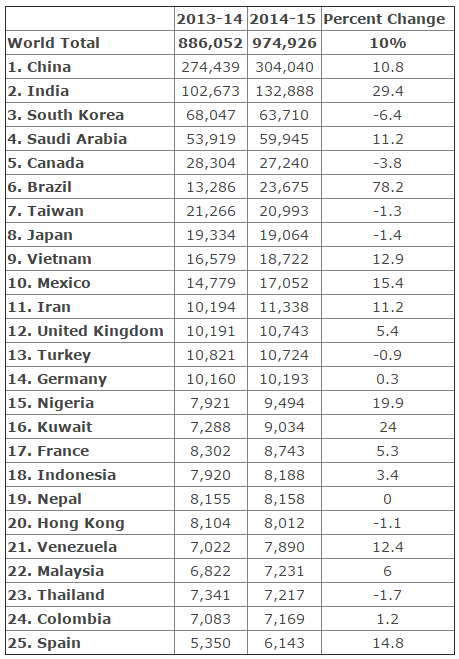|
November 16, 2015 Elizabeth Redden Nearly a million international students are studying at colleges across the U.S. The newest data from the Institute of International Education’s annual Open Doors survey shows a 10 percent increase in international students from 2013-14 to 2014-15 -- the highest annual rate of growth at any point over the last 35 years. International Students in the U.S. Of particular note is a big jump in Indian student enrollments. “While students from China still far outnumber those from any other country, the real story this year is about the growth of students from India,” said Rajika Bhandari, IIE’s deputy vice president for research and evaluation. “What we’ve found is that Indian students coming to the U.S. increased by almost 30 percent over the prior year to reach a record high of almost 133,000 students in the U.S." The majority of students from India (64 percent) study at the master’s and Ph.D. levels. The United States’ gain in students from India has come at a time when the United Kingdom has experienced declines. “We know that Indian students have always been very attracted to the availability of excellent science and research facilities on U.S. campuses and also within U.S. industry, which Indian students really view as being a leader in innovation, research and development as compared to any other destination in the world,” said Bhandari, who also cited the stabilization of the Indian rupee as a likely reason behind the increase. “Students are finally beginning to recover from the steep devaluation of the rupee against the dollar some years ago. While the rupee still remains weak, the fluctuation has stabilized to some extent, therefore allowing more students to afford a U.S. education.” India is the second-largest country of origin for international students in the U.S. The number of students from the No. 1 country of origin, China, continued to grow -- albeit at a slower rate than in recent years, by 10.8 percent. Other major sending countries with strong growth include Saudi Arabia (up 11.2 percent) and Brazil (up 78.2 percent). Both countries have generous government scholarship programs funding study abroad, though the future of Brazil’sScience Without Borders program is uncertain after the government, facing a budget crisis, announced an indefinite freeze on new awards in September. The scholarship program continues to support thousands of students who are currently abroad. "The budget for 2016 is under construction by the Brazilian Congress and until we have it we cannot indicate the exact moment that awards will be resumed," Adalberto Luis Val, the director of international relations for CAPES, a Ministry of Education entity that administers the scholarships, said via email. Latin America and the Caribbean was the fastest-growing region of origin for international students in the U.S. in 2014-15, increasing by 19 percent over the year before. The number of students from Mexico increased by 15.4 percent. The U.S. and Mexican governments have several initiatives in place to try to increase academic exchange between the two nations. Other countries of origin with double-digit growth include Vietnam (up 12.9 percent), Iran (up 11.2 percent), Nigeria (up 19.9 percent), Kuwait (up 24 percent), Venezuela (up 12.4 percent) and Spain (up 14.8 percent). There were declines in the number of students from South Korea (down 6.4 percent), Canada (down 3.8 percent), Taiwan (down 1.3 percent), Japan (down 1.4 percent), Turkey (down 0.9 percent), Hong Kong (down 1.1 percent) and Thailand (down 1.7 percent). Top Places of Origin for International Students in the U.S. A total of eight American universities enrolled 10,000 or more international students in 2014-15, up from just four the year before. Those universities are, in descending order of enrollment, New York University, the University of Southern California, Columbia University, Arizona State University, the University of Illinois at Urbana-Champaign, Northeastern University, Purdue University and the University of California at Los Angeles.
Nationally, 40.9 percent of international students are undergraduates; 37.2 percent study at the graduate level. Another 9.6 percent study in nondegree programs (including intensive English programs) and the remaining 12.3 percent are participating in a postgraduation work authorization period known as optional practical training. Click here for the entire article. Comments are closed.
|
Volunteer ServicesThe material included in this blog is a collaborative sharing of ideas by ISI staff, volunteers and partner organizations. The content of this blog is intended for informational purposes only and should not be construed as an endorsement by ISI. You can search the content using the search box above. Archives
May 2016
Categories |

 RSS Feed
RSS Feed